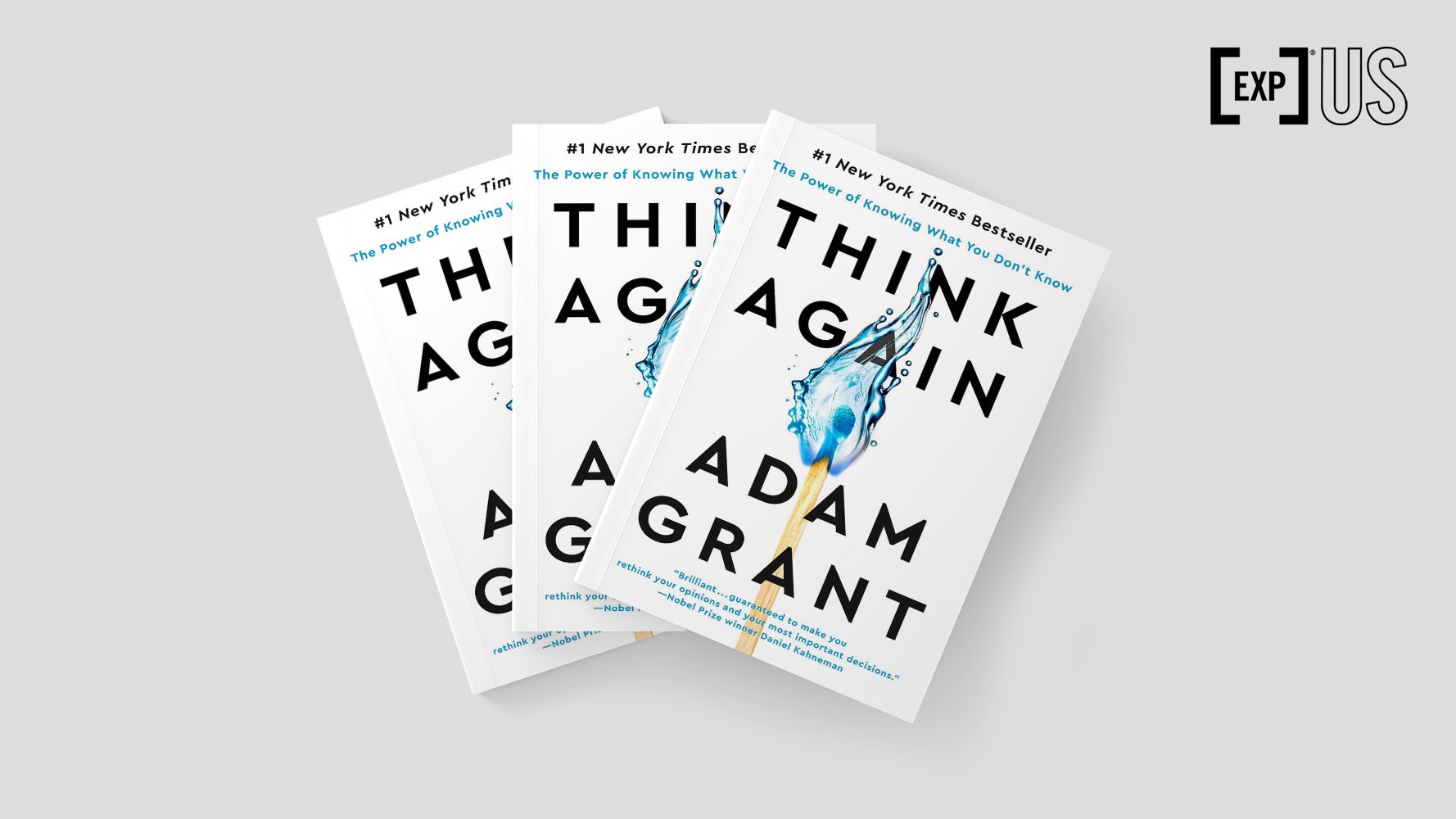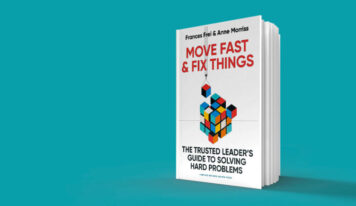The power of knowing what you don’t know – Adam Grant, one of the world’s leading references in human resources, believes that it is possible to learn to open your mind and that rethinking is a way to be prepared for change
Central ideas:
1 – Rethinking is a skill, but also a mindset. Many of the mental tools we need, we already have, we just need to remember to take them out from the bottom of the trunk and clean the rust off. Let’s get to work.
2 – While thinking, it is common for us to assume the mindset of three professions: pastor, lawyer, or politician. We go into pastor mode when our beliefs are challenged; lawyer mode, when we debunk contrary theses; and politician mode to win voters, even at the expense of the truth. It is necessary to enter the scientist mode, testing hypotheses.
3 – In American universities, more than half of the professors of exact and biomedical sciences spend at least 80% of their time giving lectures, and a little more than a quarter add interactive moments with the students.
4 – Psychological safety comprises a climate of respect, trust, and openness in which people can express concerns and make suggestions without fear of being reprimanded. It is the foundation of a learning culture.
5 – We need humility to reconsider past commitments, doubt to question current decisions, and curiosity to reimagine plans for the future. Rethinking frees us not only to update knowledge and opinions – it helps us in the pursuit of a more rewarding life.
About the author:
Adam Grant is recognized as one of the most influential scholars in the field of human resources. As a professor, in addition to being the highest-rated at the Wharton School, he has been named one of the top 40 business faculty under the age of 40. He is the author of the books Give and Take and Originals.

Introduction:
Rethought answers are not inherently better. However, recent student research shows that what makes a difference is not merely changing the answer, but reflecting on whether it should be changed.
The point is not that we are afraid to rethink answers. We are afraid of the very idea of rethinking. Let’s look at an experiment in which hundreds of college students were randomly chosen to learn about the fallacy of first instinct. A lecturer explained to them how important it was to change your mind and on what occasions to do so. Yet on the next two tests they took, the students were not the least bit more likely to reconsider their answers.
Part of the problem is creative laziness. Some psychologists claim that we are “mentally stingy”: we prefer the ease of holding on to old views to the difficulty of grasping new ideas. But there are also deeper forces behind this resistance. When we question ourselves, the world becomes more unpredictable. We are forced to admit that the facts may have changed, that something that was once right may now be wrong. Rethinking something we strongly believe in is a threat to our identity, it gives us the feeling that we are losing part of ourselves.
My goal in this book is to explore how the re-evaluation of thought takes place. I have sought out the most compelling data and some of the world’s greatest rethinkers. The first part focuses on opening our minds. You will discover why a forward-looking entrepreneur got stuck in the past, how an unexpected candidate for the presidency of her country began to see imposter syndrome as an advantage, how a Nobel Prize-winning scientist gladly accepts being wrong, how the world’s best political analysts update their opinions, and how an Oscar-winning filmmaker manages to have constructive discussions.
The second part assesses how we can encourage others to revise their concepts. You will learn how an international debate champion wins arguments, and how a black musician convinces white supremacists to abandon their hatred. You’ll also find out how a special kind of listening helped a doctor change a mother and father’s perception of vaccines, and helped a politician convince a Ugandan military leader to start peace negotiations. And if you are a Yankees fan, I will try to convince you to support the Red Sox.
The third part is about how to create lifelong learning communities. On the social side, I’ll deal with a lab specializing in difficult conversations to shed light on how we can better communicate about controversial issues such as abortion and climate change. On the school’s side, we will look at how educators teach kids to rethink by viewing classrooms as museums, approaching projects as if they were woodworkers, and rewriting established textbooks. And we will conclude with a reflection on the importance of reconsidering our more detailed plans.

PART I – Individual rethinking – How to update our own opinions
Mike Lazarides’ first success came when he patented a device to read the barcodes on film stock, something so useful to Hollywood that it won him an Emmy and an Oscar for technical contribution. And this was nothing compared to his next big invention, which turned his business into the fastest-growing company in the world. Mike’s flagship product soon attracted a legion of followers, with repeat customers ranging from Bill Gates to Christina Aguilera.
Mike Lazarides conceived BlackBerry as a portable communication device for sending and receiving e-mail. By mid-2009, the device accounted for almost half of the US smartphone market. By 2014, however, its presence had plummeted to less than 1 percent.
When a company suffers a vertiginous fall like this, it is impossible to define a single reason, so we tend to anthropomorphize it: BlackBerry failed to adapt. But adapting to a changing environment is not something a company does, it’s people, through the many, many decisions they make every day. As co-founder, president and co-CEO, Mike was in charge of all technical and product decisions at BlackBerry. Although his ideas were the spark that started the smartphone revolution, his difficulty in rethinking things ended up upholding the company’s breath and practically stifling its invention. Where did he go wrong?
Rethinking is a skill, but also a mindset. We already have many of the mental tools we need, we just need to remember to take them from the bottom of the trunk and rust them out.
With advances in access to information and technology, knowledge is not only increasing – it is increasing in greater and greater proportions. The amount of information consumed per day in 2011 was five times what it was 25 years earlier. In 1950 it took us about fifty years to double our knowledge of medicine; by 1980 it had doubled every seven years, and by 2010 it had doubled in half that time. The rapid pace of change forces us, more than ever, to learn to quickly question our beliefs.
Imagine that you have a family friend who is a financial advisor and he recommends an investment that another one of your very knowledgeable friends thinks is risky. What should you do?
When he found himself in this situation, a man named Stephen Greenspan decided to compare his suspicious friend’s warning with the available data. Stephen’s sister had been investing in the fund recommended by the advisor for many years and was satisfied, as were several friends. Although the returns were not extraordinary, they were consistently satisfactory. The consultant believed so much in the potential of the fund that he invested his own money in it. Armed with this information, Stephen decided to take a risk. In a bold move, he invested almost a third of his retirement savings in this fund. It didn’t take long to see a 25% appreciation in value.
Then, overnight, he lost everything. The fund was the infamous financial pyramid scheme created by Bernie Madoff.
Pastor, lawyer, and politician
Two decades ago, my co-worker Phil Tetlock discovered something peculiar. As we think and speak, it is common for us to assume the mindset of three professions: pastor, lawyer, or politician. In each of these modes, we assume a specific identity and use a different set of tools. We enter pastor mode when our sacred beliefs are challenged: we preach to protect and promote our ideals. We switch to lawyer mode when we recognize flaws in someone else’s reasoning: we present arguments to debunk contrary theories and win the case. We go into a political mode when we try to win over an audience: we campaign and lobby for voters’ approval. The risk of this is that we become so caught up in preaching our right beliefs, arguing against the wrong beliefs of others, and making speeches in search of support that we don’t bother to rethink our views.
It is necessary to get into scientist mode. But being a scientist is not just about a profession. It is a state of mind – a way of thinking that is different from preaching, advocacy, and politics. We enter the scientist mode when we search for truth: we perform experiments to test hypotheses and find knowledge. Scientific tools are not unique to people with white lab coats and test tubes. Hypotheses belong to our lives as much as laboratories do.
They changed Jobs’ mind
In 2004, a small group of engineers, designers, and marketers presented Jobs with the proposal to turn his most successful product, the iPod, into a telephone. “Why on earth would we do such a thing,” quipped Jobs. “It’s the most ridiculous idea I’ve ever heard.” The team had realized that cell phones were beginning to feature the ability to play music, but Jobs thought they would end up cannibalizing Apple’s lucrative iPod market. He hated cell phone companies.
Research shows that when you are dealing with someone who resists change, it is important to reinforce what will stay the same. Thinking about change becomes more interesting when it includes continuity. Although our strategy is capable of evolving, our identity persists.
The engineers who worked with Jobs knew that this was one of the best ways to convince him. They assured him that they would not turn Apple into a cell phone company. It would continue to sell computers – the plan was to keep the existing products and just add a cell phone. Apple already put 20,000 songs in people’s pockets, why not put everything else? The technology would need to be rethought, but the DNA of the company would be preserved. After six months of discussing the idea, Jobs finally became curious enough to accept it, and two different teams began an experimental race to determine whether to add calling capability to the iPod or turn the MAC into a miniature tablet that could also serve as a phone. Just four years after its launch, the iPhone was responsible for half of Apple’s profits.
One of the world’s leading experts on conflict is an organizational psychologist from Australia named Karen “Etty” John. When you think of conflict, you probably visualize what Etty calls personal conflict: personal, emotional fights filled not only with friction but also with hostility. I hate you with all my might. I’ll speak slowly to see if you understand me, you idiot. You seem to enjoy humiliating yourself.
But Etty identified another type, called functional conflict: clashes over ideas and opinions. We have a functional conflict when we argue about which candidate to hire, in which restaurant to dine, or whether to name our child Gertrude or Quasar. The point is that the two types of conflict have different consequences.
In one survey, the groups with poor performance started with more personal conflict than functional conflict. They started private feuds and were so busy hating each other that they didn’t feel comfortable challenging each other. Many of the teams took months to smooth out their relationship problem, and by the time they finally got around to debating fundamental decisions, it was too late to rethink their course.
What happened to the well-performing groups? As expected, they started with a few personal conflicts and stayed that way throughout their work. This did not prevent them from having functional conflicts from the very beginning: no one hesitated to expose opposing perspectives. By resolving a few disagreements, they were able to reach a consensus on the direction to go until they were faced with new issues to debate.
By the year 2000, Pixar was in full swing. They had used computers to rethink animation in their first hit, Toy Story, and had just released two more outstanding films. But the company founders didn’t want to stop there. They recruited an outside director named Brad Bird to give it a fresh start. Brad had just released his first feature film, which had been a critical success but a failure at the box office, so he was excited to do something big and bold. When he presented his idea, Pixar’s technical leadership said it would be impossible: they would need a decade and $500 million to execute it.
Notice what Brad didn’t do. He didn’t fill his team with likable people. That kind of personality forms great teams and support networks, who like to encourage us and cheer for our success. Rethinking needs a different network: a challenger group, made up of people we trust to point out blind spots and help us overcome weaknesses. Their role is to activate cycles of rethinking, pushing us to see our capacity with humility, to doubt our talents, and to be curious about new perspectives.
I have seen many leaders run away from functional conflicts. As they gain power, they ignore the questioners and listen to the suckers. They become politicians, surrounding themselves with agreeable sycophants and becoming more vulnerable to the seduction of the bootlickers. Research shows that when their companies perform badly, CEOs addicted to praise and compliance show overconfidence. They remain attached to old strategies instead of changing course – and are on a collision course with failure.

PART II – Interpersonal rethinking – How to open other people’s minds
During my childhood, my karate sensei taught me never to start a fight that I couldn’t win. This was my stance in debates at work and with friends: I thought that the secret to victory was to enter the battle armed with irrefutable logic and precise data. But the more I attacked, the more my opponents defended themselves. My sole focus was to convince them to accept my views and rethink theirs, but I ended up behaving in pastor and lawyer modes. Although these mentalities motivated me to keep arguing, it was common for me to end up in a disagreement with the audience. I did not win.
For centuries and centuries debate has been appreciated as an art, but today there is a growing science of how to get the best results. In a formal debate, the goal is to get the audience to change their minds. In informal ones, we try to change the opinion of our interlocutor. It is almost like a bargain, and you and I try to reach a consensus on the truth. I studied the psychology of negotiation to absorb more knowledge and improve my ability to win debates, and over time I used what I learned to teach techniques to business and government leaders. I eventually became convinced that my instincts – and what I learned in karate – were completely wrong.
In a war, the goal is to gain ground, not lose, so we are usually afraid to surrender in some battles. In a negotiation, agreeing with the opponent’s argument is an appeasing act. The experts recognized that, in dance, they could not stand still and wait for the other people to perform all the steps. To have harmony, they needed to take a step back from time to time.
A difference was visible even before any volunteer sat down at the negotiating table. Before starting, the researchers interviewed both groups about their plans. The average negotiators were armed for the fight, taking almost no account of any issues that everyone could agree on. The experts, on the other hand, mapped out a series of dance steps they could perform with the other side, devoting more than a third of their planning to finding a common denominator.
As the negotiators began to discuss options and make proposals, a second difference emerged. Most people think that discussions are like scales: the more reasons we stack on one side, the more it tips in our favor. However, the experts did the complete opposite: they gave fewer reasons to defend their case. They did not want to weaken their best arguments. As Rackham explained, “A weak argument usually dilutes a strong one.”
Vaccine charmers
Today, in the developed world, for the first time in at least 50 years the measles contagion rate is up and the death rate is at about 1 for every thousand people. In developing countries, the number is approaching 1 per 100. Estimates suggest that between 2016 and 2018 there was a 58% rise in measles deaths, adding up to 100,000 more victims in that period. These fatalities could have been prevented by the vaccine, which has saved an estimated 20 million lives over the past two decades.
If fear of the vaccine was unfounded, it was time to offer a real dose. Overall, the results were unsatisfactory. In a pair of experiments in Germany, attempts to present research on the safety of vaccines backfired: people ended up believing that vaccines were even riskier. There seemed to be no logical arguments or data-based explanations that could shake the belief that vaccines are dangerous.
Little Tobie, Marie-Hélène Étienne-Rousseau’s son, was finally released from measles treatment after five months in the hospital, but he remained very vulnerable. The nurses knew that this would be the last chance to vaccinate him, so they called in a vaccine charmer: a local doctor with a radical approach, to help young parents rethink their resistance to immunizations. He didn’t preach or argue against guardians, he didn’t act like a pastor, lawyer, or politician. He went into scientist mode and interviewed them.
The process of motivational interviewing involves three fundamental techniques:
– Asking open-ended questions (those whose answer is not limited to yes or no).
– Listening in a reflective manner
– Affirming the other person’s desire and ability to change
As Marie-Hélène prepared to take Tobie home, the nurses called in the vaccine charmer, a neonatologist and researcher named Arnaud Gagneur. His specialty was applying motivational interviewing techniques to discussions about vaccines.
Arnaud told Marie-Hélène that he was afraid of what might happen to Tobie if he caught measles, but that he accepted her decision and wanted to understand it. For more than an hour, the doctor asked open-ended questions about how she had come to the decision not to vaccinate. He listened to the answers carefully. At the end of the conversation, Arnaud reminded Marie-Hélène that she was free to immunize her child or not.
Victory. Before leaving the hospital, Marie-Hélène vaccinated Tobie.

PART III – Collective Rethinking – How to create communities of lifelong learners
For eight years, Erin McCarthy has been teaching a social studies class in the Milwaukee, Wisconsin area. Her mission is to cultivate interest in the past, but also to motivate students to update their knowledge of the present. In 2020, she won the state’s Teacher of the Year award.
One day, a student complained about a wrong passage in the history textbook. For a teacher, this kind of criticism can be a nightmare. Using an outdated textbook would be a sign that you don’t know the material, and it would be embarrassing for students to notice the error first.
But Erin had passed that reading assignment on purpose. She collects old history books because she likes to see how the narratives change over time. That excerpt was from 1940 material. Some simply accepted the information presented, without question – over years of education, they have come to accept that textbooks present the truth. Others were horrified by the errors and omissions; their minds were steeped in the conception that reading materials convey unquestionable facts. The lesson made them begin to think like scientists and what they were missing if only one or two perspectives were told.
In history education, there is a growing movement toward asking questions that do not have a single right answer. In a curriculum developed at Stanford, high school students are encouraged to critically examine the events leading up to the Spanish-American War, whether or not the New Deal was a success, and why the bus boycott in Montgomery was a watershed. Some professors even ask students to interview people they disagree with. The focus is not on being right, but on developing skills to reflect on different points of view and to discourse productively.
In American universities, more than half of the professors in exact and biomedical sciences spend at least 80 percent of their time lecturing, just over a quarter add interactive moments, and less than a fifth use truly student-centered active learning methodologies. In high schools, it is assumed that half the teachers work in lecture mode most or all of the time. This method of learning is not always the most effective, and it is not capable of turning students into lifelong learners. If you spend all your school years receiving information without ever having the opportunity to question it, you will not develop the necessary tools to learn and rethink.
Psychological safety
Years ago, Amy Edmondson, an engineer turned business professor, became interested in the prevention of medical errors. She went to a hospital and asked employees how psychologically safe they felt at work: could they make risky decisions without fear of being punished? Then she gathered data on the number of medical errors made by each staff member, tracking serious failures such as potentially fatal doses of the wrong drugs. To her surprise, the more psychological safety a team felt, the higher the rate of errors made. It seemed that psychological safety led to complacency.
However, Edmondson soon recognized an important limitation of the data: all the errors had been reported by the culprits themselves. To be able to measure the errors impartially, she sent an undercover observer to the units. When analyzing this data, the results were the opposite: teams that felt psychologically secure reported more errors but made them much less frequently. Because they were not afraid to admit their mistakes, these employees were able to understand the reasons behind the error and avoid repeating them. The groups that did not feel psychologically secure hid their mistakes to avoid punishment, making it difficult to identify their origins and prevent future problems. The same mistakes were repeated over and over again.
Since then, research on psychological safety has taken off. When I worked on a study at Google to identify the factors that characterized high-performing teams with high well-being, the most important element was not who was in the group or the purpose they had at work. The differentiator was psychological safety.
Edmondson makes the point that psychological safety is not about lowering the bar, making people more comfortable, being nice and friendly, or giving unwarranted compliments. It is about nurturing a climate of respect, trust, and openness in which people can express concerns and make suggestions without fear of being reprimanded. It is the foundation of a learning culture.
PART IV – Conclusion
When we devote ourselves to a plan and it doesn’t turn out as expected, our first instinct is hard to rethink it. We tend to stubbornly persist and invest more resources in it. This behavior is called commitment escalation.
One of the main reasons for failures that could have been prevented is an escalation of commitment. Ironically, it can be fueled by one of the most lauded drivers of success: tenacity – a mixture of passion and perseverance. Research shows that it can play an important role in motivating people to achieve long-term goals, but when it comes to rethinking, it can have a dark side. Experiments indicate that tenacious people have a greater tendency to spend more time than they should gambling and are more willing to persist with tasks that are going wrong, even when success is impossible. Researchers even suggest that tenacious climbers are more likely to die on expeditions because they are willing to do anything to reach the peak. There is a fine line between heroic persistence and foolish stubbornness. Sometimes the best kind of tenacity is to bite your teeth and turn around.
When my students talk about the evolution of self-esteem in their careers, the progression usually goes like this:
Stage 1: I am not important
Stage 2: I am important
Stage 3: I want to contribute something important
I have noticed that the faster they get to stage 3, the more impact they have and the happier they feel. This makes me think of happiness less as a goal and more as a result of fitness and purpose. The philosopher John Stuart Mill wrote: “Only those are happy who have their minds focused on some object other than their happiness: on the welfare of others, on the betterment of mankind, even on some art or pursuit, pursued not as a resource but as an ideal. Thus, by aiming at something different, they find happiness along the way.”
Rethinking
We need humility to reconsider past commitments, doubt to question current decisions, and curiosity to reimagine plans for the future. What we discover along the way can free us from the chains of our familiar surroundings and our old versions. Rethinking frees us not only to update knowledge and opinions – it helps us to pursue a more rewarding life.

FACTSHEET:
Original Title: Think Again
Author: Adam Grant
Photos: Disclosure. Pro stock-studio/adobe stock, Lenscap50/adobe stock, Fotokitas/adobe stock, Antonio Guillem/adobe stock
Review: Rogério H. Jonck
![[Experience Club] US [Experience Club] US](https://experienceclubus.com/wp-content/uploads/2021/03/laksdh.png)










![[Experience Club] US [Experience Club] US](https://experienceclubus.com/wp-content/uploads/2021/03/logos_EXP_US-3.png)





![[EXP no SXSW 2024] Rohit Bhargava: como o pensamento não-óbvio pode melhorar o mundo](https://experienceclubus.com/wp-content/uploads/2024/03/rohit-356x206.jpg)

